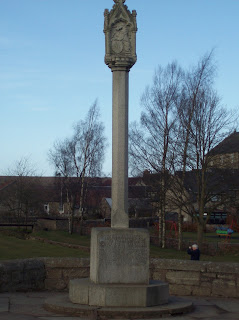Isn't it amazing how often we have something truly unique practically on our doorstep but somehow never actually go and see it?
I'm as guilty of that as anyone who reads this blog. There are many wonderful places on the Fife coast of the Firth of Forth, and the Wemyss Caves are among them. If you live in Fife, you will have heard of the Wemyss Caves. You may not have paid much attention to what you heard because caves are just spaces worn, carved or eroded in walls of rock, right? Well, maybe...
A few weeks ago I checked out Save Wemyss Ancient Caves Society's Facebook page https://www.facebook.com/SaveWemyssAncientCavesSociety/ and found out they were offering tours of the caves. So, Reader, I booked a place and went.
The group met at the Primary School, and our guide took us down to the Shore and we walked towards the caves.
Wemyss Caves were formed by the action of the sea on the sandstone cliffs nine thousand years ago, and more caves were formed as the landmass rose. They have had many uses over the millennia as Law Courts, doocots and glassworks.
A large cave on the west side of the Michael Colliery housed the glassworks. Glass was first produced here in 1610, and it was one of the earliest glassworks in Scotland.
The Michael Colliery shafts were sunk to the east of the cave in 1898 and the seams of coal under the cave were worked. Thus, the cave was undermined and the cave collapsed with a load roar in 1901.
There are two ghost stories connected with the Court Cave. It is also known as the Piper's Cave because a piper marched into the cave playing his pipes and was never seen again. This legend of a smothered piper is linked to Dairsie Castle, Culross and a cave in the cliffs of St Andrews. In each case, a piper is said to have been exploring a tunnel while playing his pipes so that his progress could be traced. The piping stopped, and, in every single case, instead of entering the cave to try to rescue him, observers waited a respectful time, then sealed the cave. The other ghost is the White Lady, Mary Sibbald, who was the daughter of the Laird of Balgonie Castle. She ran away with a gypsy. The gypsy's jealous ex-girlfriend, Jean Lindsey, claimed that a piece of her jewellery had been stolen. The jewellery was found underneath Mary's sleeping-mat where the ex-girlfriend had planted it., and Mary was 
ordered to have twelve lashes of the whip. Mary is said to have died of a broken heart in the Well Cave. On one occasion when a gypsy was lying about an innocent young girl in the Court Cave the words "you were a thief" rang out, and the ghost of the White Lady appeared and then disappeared. She haunted the gypsies until Jean Lindsey admitted her guilt. It is said that the White Lady can still sometimes be seen around the Castle and the Court Cave to this day.
The Court Cave
At one point we climbed up to MacDuff Castle, home to Macbeth's Macduff and the place where his wife and sons were murdered by Macbeth
Pictish markings in Wemyss Caves. There are more Pictish markings in the Wemyss Caves than in all the other caves in Britain put together. Over the years damage has been done to these caves by vandals and the Save Wemyss Ancient Caves Society was formed in 1986 to protect and preserve this important piece of Scottish heritage. www.wemysscaves.org
Wemyss Caves, where you can look out from Pictish drawings towards modern technology. Just one moment in time.































